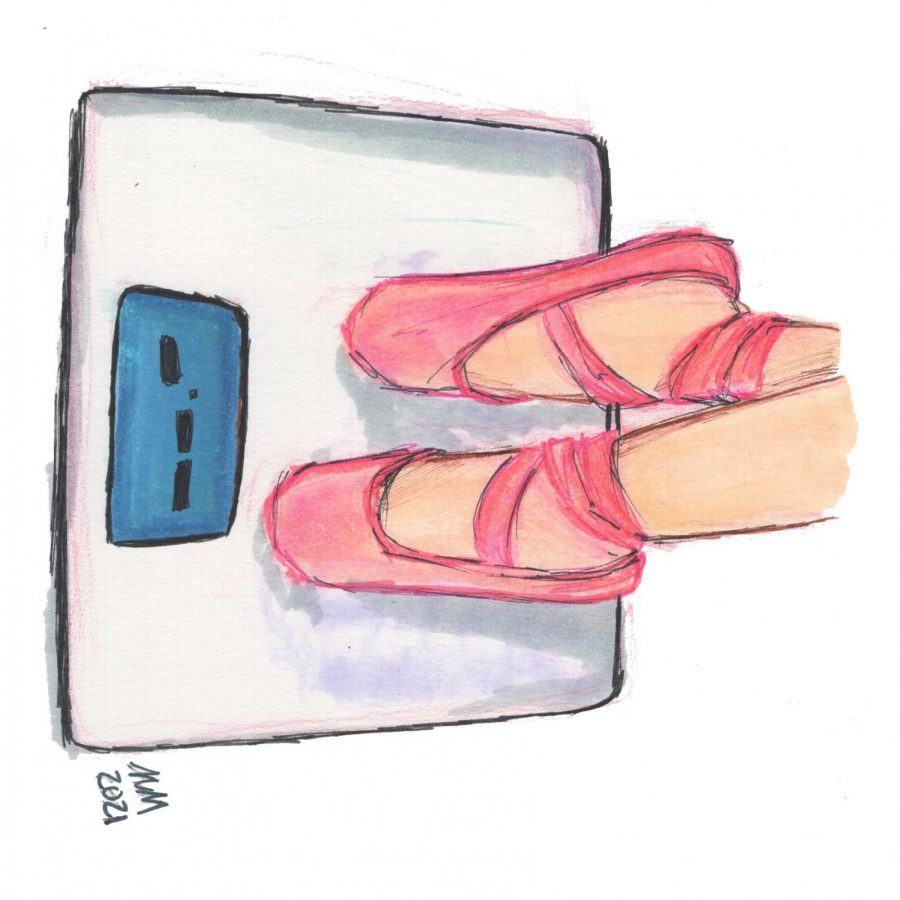Internal Struggles
Restriction and pressure has taken hold of the younger generation
April 29, 2021
Young teens find themselves on social media comparing their looks to the so-called “influencers” based on 15 second videos or edited pictures. This comparison sometimes manifests itself in physical ways such as restriction, purging, binging or excessive exercise — which are all tell-tale signs of an eating disorder.
The most common eating disorders are anorexia, bulimia, binge eating disorder, orthorexia or avoidant/restrictive food intake disorder (ARFID). These can be accompanied by body dysmorphic disorder, which creates an unrealistic view of what one looks like and an obsession with how one appears.
Each eating disorder is characterized differently and can vary in extremities or symptoms.
A lack of serious symptoms or changes does not determine whether a person is struggling with an eating disorder or not. However, mindset plays a large role.
Health teacher Phil Wickwar hasn’t personally dealt with an eating disorder, but through his teaching and exposure has learned much about them.
“I think some of the misgivings are that it is a mental disorder,” Wickwar said. “I think we all have body awareness and positivity concerns, but this is a true mental disorder that’s not gonna be solved by eating food — it’s going to be solved by dealing with that wound we have mentally and emotionally.”
More commonly, people deal with disordered eating. Cassie Dimmick, a registered nutritionist at Achieving Your Best, helps those struggling with problems related to food and eating. A more common struggle, disordered eating, is something that Dimmick deals with the most.
Disordered eating is qualified as irregular eating behaviors or thoughts that are not as severe as an eating disorder but still have common attributes.
“Disordered eating, which is not as extreme as an eating disorder, but still has negative physical and emotional ramifications,” Dimmick said. “They are more difficult to diagnose because there is more grey area, but an online survey in a research study in over 4,000 women showed 3 in 4 of them had disordered eating.”
Eating disorders are extremely detrimental to one’s health. According to anad.org, even though only 9 percent of the world population deals with one, there are 10,200 deaths a year directly due to eating disorders. That equals one death every 52 minutes.
“There are physical and mental effects,” Dimmick said. “Some of the physical effects include stomach problems, risk of stomach or esophagus rupture, fainting, low blood sugar, electrolyte imbalances, lack of energy, insomnia, hormone imbalances, bone loss, heart problems, using essential muscle to fuel the body, fine hair covering body (called lanugo) in an attempt to keep the body warm, decreased immune function and death. Mental effects include depression, anxiety and difficulty concentrating and increased suicide risk.”
There are common symptoms that can hint at someone struggling. These can be obsessive behaviors about food or exercise, extreme mood swings, withdrawal, wearing lots of layers or always being cold, amenorrhea (loss of menstrual period), dry skin and excessive hair loss. Additionally, people with eating disorders are more at risk to deal with irritable bowel syndrome-type symptoms — stomach problems and intolerance to certain foods.
Social media can be to blame for the increase of insecurities in the younger generation. It has become increasingly easy to change one’s appearance with a few filters or edits, leading to a miscommunication on what ones body truly looks like.
“Social media promotes over-emphasis on appearance that may not be realistic due to differences in genetics, filters and photo editing,” Dimmick said. “It also allows further reach when people are talking negatively about themselves or others, and it allows influencers with very little nutrition knowledge to post their diets and unhealthy habits. Social media is often not based on reality, which is not helpful when you are trying to figure out sustainable healthy habits. For younger kids and teens, it can be very hard to decipher this information and make choices that are healthy and it can increase the pressure to conform with what is popular because they are inundated by it every day.”
Social media has also brought a large amount of unhealthy comparison into the world.
“I think it’s natural to compare,” Wickwar said. “However, comparison is a real foundation for unhappiness in our society. The closer I get to embracing my blessings and areas of improvement is when I begin to find happiness. Everyone has a chance to be a better version of yourself tomorrow.”
Body positivity is a movement that has come into popularity on social media in the past few years. It has created a more realistic image for young teens and children and is more inclusive.
However, some people, like Wickwar, have reached body positivity by themselves.
“I think I come from a narrow mindset because of my faith,” Wickwar said. “I think I was built for a reason and a purpose. The more I grow and understand and respect my body, the more I accept the flaws and the positives as part of who I am.”
Looking at oneself positively is not easy, and it takes work to rewire the brain to think in that way.
“Understand what the best you looks like and don’t compare yourself to others,” Wickwar said. “Embrace what you have, that’s what life is about. When I spend time investing in my body, I start to accept it. The pursuit should be about accepting yourself.”







